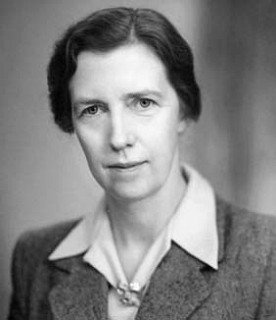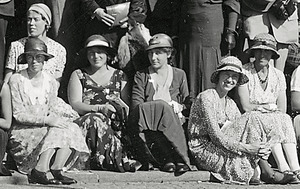Mary Cartwright facts for kids
Quick facts for kids
Dame Mary Cartwright
|
|
|---|---|
 |
|
| Born | 17 December 1900 Aynho, Northamptonshire, England, UK
|
| Died | 3 April 1998 (aged 97) Cambridge, England, UK
|
| Alma mater | St Hugh's College, Oxford |
| Known for | Cartwright's Theorem, Research about the Butterfly effect |
| Awards | FRS DBE De Morgan Medal (1968) Honorary Fellow, Royal Society of Edinburgh (HonFRSE) 1968 Sylvester Medal (1964) |
| Scientific career | |
| Doctoral advisor | G. H. Hardy |
| Doctoral students | |
| Other notable students | Sheila Scott Macintyre |
| Influences | J. E. Littlewood |
Dame Mary Lucy Cartwright (December 17, 1900 – April 3, 1998) was an important British mathematician. She helped start a field of study called chaos theory. This field looks at how tiny changes can lead to big, unpredictable results. Mary Cartwright, along with J. E. Littlewood, found many answers to a math problem. Their work later became a famous example of the butterfly effect. This effect shows how a small event, like a butterfly flapping its wings, could theoretically cause a hurricane far away.
Contents
Early Life and School
Mary Cartwright was born on December 17, 1900. Her hometown was Aynho, in Northamptonshire, England. Her father, William Digby, was a vicar, which is a type of priest. Mary had four brothers and sisters. Two were older than her, and two were younger.
She went to several schools as a child. These included Leamington High School and Gravely Manor School. She finished her early education at Godolphin School in Salisbury in 1919.
Mary then went to St Hugh's College, Oxford to study mathematics. She was a very good student and graduated in 1923 with top honors.
After graduating, she taught for a short time. She worked at Alice Ottley School and Wycombe Abbey School. In 1928, she went back to Oxford to work on her advanced degree, called a D.Phil. Her main teacher for this was G. H. Hardy.
While Hardy was away, another mathematician, E. C. Titchmarsh, helped supervise her studies. In 1930, Mary finished her D.Phil. Her special project was called "The Zeros of Integral Functions of Special Types." One of the people who checked her work was J. E. Littlewood. This was the first time she met him.
In 1930, Mary won a special award called a Yarrow Research Fellowship. This allowed her to go to Girton College at the University of Cambridge. There, she kept working on her D.Phil topic. She also went to lectures given by Littlewood. She even solved a difficult math problem that he had presented.
Her solution became a famous math rule called Cartwright's Theorem. This theorem helps to estimate how large a certain type of math function can get. To prove her theorem, she used a new method. This method was based on ideas from another mathematician named Lars Ahlfors.
Her Amazing Career
Mary Cartwright had a long and important career in mathematics. Here are some of her key roles and achievements:
- In 1936, she became the director of math studies at Girton College. This meant she was in charge of the math programs there.
- Starting in 1938, she worked on a new project. This project had a big impact on her future research. Her discoveries helped shape the modern study of dynamical systems. These systems describe how things change over time. She and Littlewood also helped engineers find ways to deal with electrical "noise."
- In 1945, Mary made a simpler way to prove that the number π is irrational. This means Pi cannot be written as a simple fraction.
- In 1947, she was chosen to be a Fellow of the Royal Society. This is a very high honor for scientists in the UK. She was the first female mathematician to receive this award.
- In 1948, Mary was appointed Mistress of Girton. This meant she was the head of Girton College.
- From 1959 to 1968, she was a Reader in the Theory of Functions at Cambridge. This is a special teaching and research position.
- She was also president of the Cambridge Association of University Women from 1957 to 1960.
- After she retired from Girton, she taught as a visiting professor. She taught at Brown University in the US from 1968 to 1969. Then she taught at Claremont Graduate School from 1969 to 1970.
Awards and Honors
Mary Cartwright broke many barriers for women in science. She was the first woman to achieve many important things:
- She was the first woman to be on the Council of the Royal Society.
- She was the first woman to be President of the Mathematical Association (in 1951).
- She was the first woman to be President of the London Mathematical Society (from 1961 to 1962).
- She was the first woman to receive the Sylvester Medal (in 1964). This is a top award for math research.
- She was the first woman to receive the De Morgan Medal (in 1968). This is the highest award from the London Mathematical Society.
In 1968, she was also made an Honorary Fellow of The Royal Society of Edinburgh. In 1969, Queen Elizabeth II honored her. Mary became Dame Mary Cartwright, a Dame Commander of the Order of the British Empire. This is a very special title given for great achievements.
Later Life and Death
Mary Cartwright passed away in a nursing home in Cambridge on April 3, 1998. She was 97 years old.
Interesting Facts About Mary Cartwright
- Mary was related to famous people from history. Through her grandmother, she was a descendant of the poet John Donne. She was also related to William Mompesson, a vicar known for his work during a plague.
- At Oxford University, she was the first woman to attend the final degree lectures. She was also the first woman to earn a first-class degree in mathematics there.
- Throughout her career, Mary Cartwright wrote over 90 articles about different math ideas.
- She studied many complex topics in mathematics. These included Dirichlet series, Abel summation, and the behavior of analytic functions.
Publications
- 1956: Integral Functions, a book in the Cambridge Tracts in Mathematics series.
Images for kids
See also
 In Spanish: Mary Cartwright para niños
In Spanish: Mary Cartwright para niños



